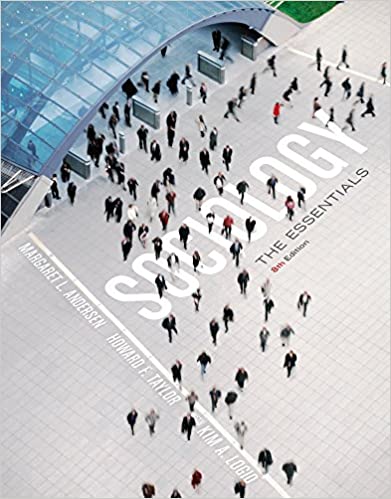
Sociology 8th Edition by Margaret Andersen ,Howard Taylor ,Kim Logio
Edition 8ISBN: 978-1285431321
Sociology 8th Edition by Margaret Andersen ,Howard Taylor ,Kim Logio
Edition 8ISBN: 978-1285431321 Exercise 2
Precarious Work: The Shifting Conditions of Work in Society
The American labor force has historically provided most people (though not all) with fairly steady work. Once in the labor market, a person could count on a relatively stable job over the course of a lifetime, often in the same company. Now that is more rare than common, resulting in a new phenomenon, labeled by sociologist Arne Kalleberg as "precarious work." Precarious work is defined as work that is uncertain, unpredictable, and risky from the point of view of a worker (Kalleberg 2009).
Research Question: What are the social conditions that have made work more precarious and made workers less secure in their employment?
Research Methods: Kalleberg has studied these questions using a macrolevel approach, drawing from secondary data sources, such as information from the U.S. Department of Labor, U.S. Department of Education, the General Social Survey, the Economic Policy Institute, and his own analyses of other published research studies.
Research Results: Kalleberg finds that the growth of precarious work produces increased stress for workers, thus also affecting families and personal relationships. He documents several reasons for this particular transformation in employment:
1. The expansion and institutionalization of nonstandard employment relations, such as temporary work and contract labor;
2. A general decline in job stability, meaning that people do not remain with the same employer over time;
3. An increasing tendency for employers to hire workers from outside of the work organization, rather than developing skills and talents from within;
4. Growth in involuntary job loss, especially among prime-age white men in white-collar occupations;
5. Growth in long-term unemployment;
6. A shift of risk from employers to employees, particularly in the decline of employee benefits;
7. Decline of unions and worker protections as employers have sought greater flexibility in management practices and the protection of profit margins.
Conclusions and Implications: Work is central to people's identity. As these various and multiple social, economic, and political forces have aligned, work has become more precarious and thus eroded people's sense of security. Kalleberg argues that new forms of work arrangements will be needed to ensure that employees, not just employers, have a commitment to the economy and society.
Questions to Consider
How do you see the social factors that Kalleberg identifies as influencing the work of people in your social networks?
The American labor force has historically provided most people (though not all) with fairly steady work. Once in the labor market, a person could count on a relatively stable job over the course of a lifetime, often in the same company. Now that is more rare than common, resulting in a new phenomenon, labeled by sociologist Arne Kalleberg as "precarious work." Precarious work is defined as work that is uncertain, unpredictable, and risky from the point of view of a worker (Kalleberg 2009).
Research Question: What are the social conditions that have made work more precarious and made workers less secure in their employment?
Research Methods: Kalleberg has studied these questions using a macrolevel approach, drawing from secondary data sources, such as information from the U.S. Department of Labor, U.S. Department of Education, the General Social Survey, the Economic Policy Institute, and his own analyses of other published research studies.
Research Results: Kalleberg finds that the growth of precarious work produces increased stress for workers, thus also affecting families and personal relationships. He documents several reasons for this particular transformation in employment:
1. The expansion and institutionalization of nonstandard employment relations, such as temporary work and contract labor;
2. A general decline in job stability, meaning that people do not remain with the same employer over time;
3. An increasing tendency for employers to hire workers from outside of the work organization, rather than developing skills and talents from within;
4. Growth in involuntary job loss, especially among prime-age white men in white-collar occupations;
5. Growth in long-term unemployment;
6. A shift of risk from employers to employees, particularly in the decline of employee benefits;
7. Decline of unions and worker protections as employers have sought greater flexibility in management practices and the protection of profit margins.
Conclusions and Implications: Work is central to people's identity. As these various and multiple social, economic, and political forces have aligned, work has become more precarious and thus eroded people's sense of security. Kalleberg argues that new forms of work arrangements will be needed to ensure that employees, not just employers, have a commitment to the economy and society.
Questions to Consider
How do you see the social factors that Kalleberg identifies as influencing the work of people in your social networks?
Explanation
Sociologist Mr. K has done a research an...
Sociology 8th Edition by Margaret Andersen ,Howard Taylor ,Kim Logio
Why don’t you like this exercise?
Other Minimum 8 character and maximum 255 character
Character 255


